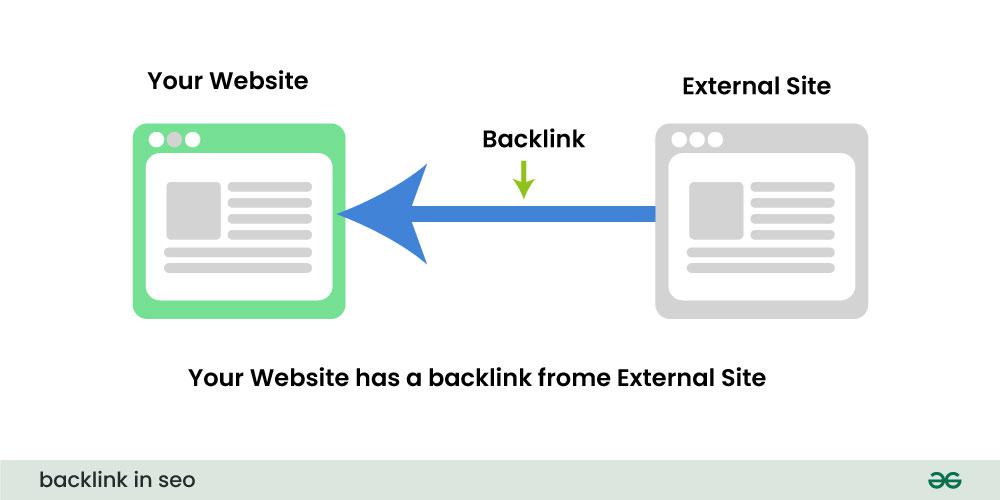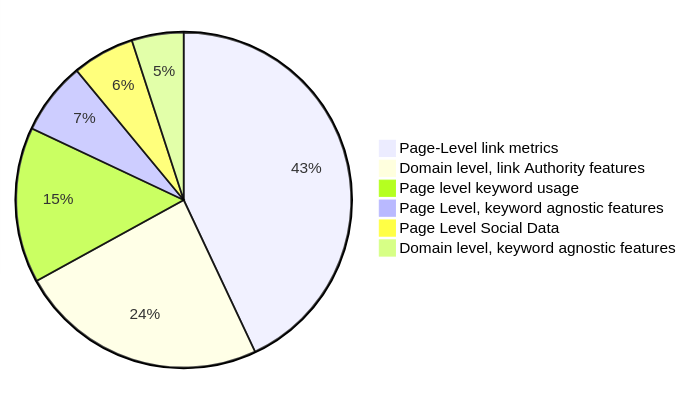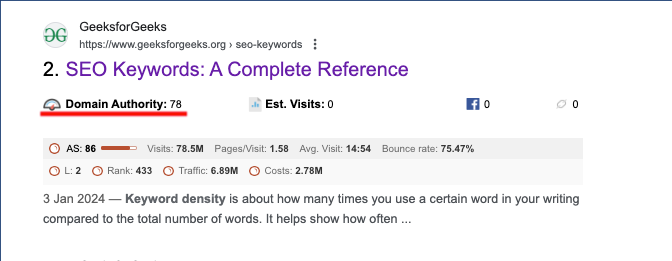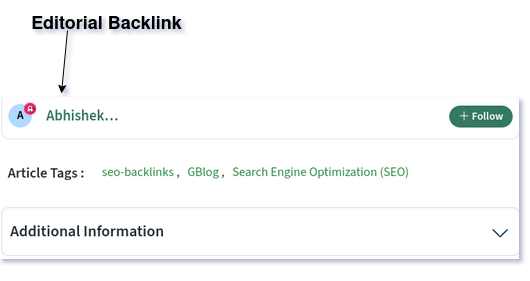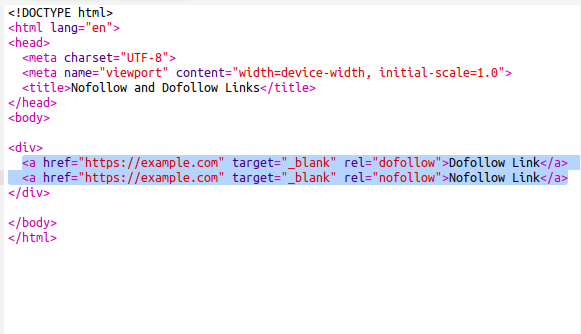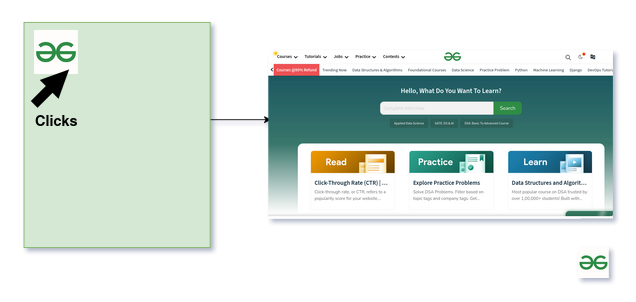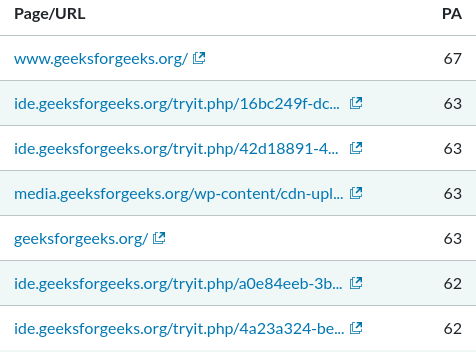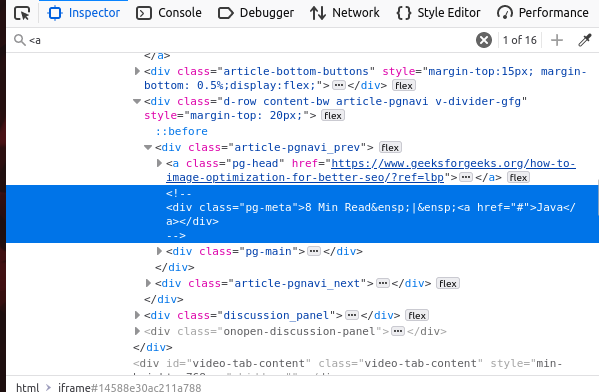Backlinks are the links on a website that connect back to a particular website. From a client’s point of view, backlinks give an approach to individuals to discover different sources of information on equivalent or related topics. It is a type of citation or hyperlink, in which someone can refer to your website. A webpage containing a lot of backlinks tended to rank higher on all significant web search engines. Backlinks are also known as inbound links, in-links, incoming links, or inward links.

Backlink Example
Table of Content
What Is Backlink

A backlink, or inbound link, is a hyperlink that points from one webpage to another. These links are crucial in the world of search engine optimization (SEO) and online visibility. Let’s delve into a more detailed definition:
- Hyperlink from External Source:
- A backlink originates from a webpage external to the one it points to. It involves a hyperlink, typically in the form of text or an image, that directs users from one website to another.
- Linking Source Characteristics:
- The website or webpage providing the hyperlink is the linking source. This source can be another webpage, blog, forum, social media platform, or any online content.
- Linked Target Characteristics:
- The webpage or website to which the hyperlink points is the linked target. Backlinks contribute to the linked target’s online presence, authority, and search engine ranking.
- SEO Importance:
- Backlinks are a fundamental factor in SEO algorithms. Search engines, like Google, use backlinks to evaluate the relevance, authority, and credibility of a webpage. Pages with a higher number of quality backlinks are often considered more valuable and are likely to rank higher in search results.
- Quality and Relevance:
- The quality of a backlink is determined by the authority and trustworthiness of the linking source. Relevance is crucial, and backlinks from websites with content related to the linked target are considered more valuable.
Importance of Backlinks in SEO:
Backlinks, also known as inbound links or incoming links, are links from one website to another. They play a crucial role in the field of search engine optimization (SEO) and are considered important for several reasons:
- Search Engine Ranking:
- Backlinks are a significant ranking factor for search engines. Search algorithms, such as Google’s PageRank, consider the quantity and quality of backlinks when determining the relevance and authority of a webpage. Websites with a higher number of quality backlinks are often considered more authoritative and may rank higher in search results.
- Backlinks are a significant ranking factor for search engines. Search algorithms, such as Google’s PageRank, consider the quantity and quality of backlinks when determining the relevance and authority of a webpage. Websites with a higher number of quality backlinks are often considered more authoritative and may rank higher in search results.
search engine ranking factors
- Backlinks from reputable and authoritative websites act as endorsements or votes of confidence for your content. When authoritative sites link to your pages, search engines interpret this as a sign that your content is trustworthy and valuable.
Domain Authority
- Backlinks serve as pathways for referral traffic. When users click on a link from one website to another, they are directed to the linked page, generating additional traffic. Quality referral traffic can positively impact a website’s overall visibility and user engagement.
- Search engine bots use links to discover and crawl web pages. Backlinks help search engines navigate and index the vast expanse of the internet more efficiently. They act as a bridge between different websites and facilitate the discovery of new content.
Crawling, indexing and ranking in Search Engine
- The quality of backlinks is an indicator of the quality of your content. High-quality content is more likely to attract organic, relevant backlinks from reputable sources. Conversely, low-quality content may struggle to earn meaningful backlinks.
- In competitive industries, the number and quality of backlinks can be a differentiating factor. Websites with a strong backlink profile are often better positioned to outrank competitors in search engine results.
- Backlinks contribute to brand visibility and awareness. When your website is mentioned and linked by other reputable sites, it exposes your brand to a wider audience and establishes your site as a credible resource in your niche or industry.
- As your content gains visibility and authority, you may attract natural and organic backlinks without active outreach. This natural link growth is a positive signal to search engines that your content is resonating with users.
Backlinks VS Normal Links:

Backlinks vs Normal LInks

Backlinks vs Normal LInks
| Feature | Backlink | Normal Link |
|---|---|---|
| Definition | Links pointing from external websites to your website. | Links within your website point to other pages or external sites. |
| Direction | Inbound links, coming from external sources. | Outbound links, go from your site to other sites. |
| Purpose | Improve search engine rankings, authority, and credibility. | Provide navigation and reference within the content. |
| Impact on SEO | Significant impact; is considered a crucial ranking factor. | Limited impact; contributes to overall site structure. |
| Quality Matters | High-quality backlinks from reputable sites are more valuable. | Links should be relevant and contribute to user experience. |
| Anchor Text Importance | Anchor text in backlinks influences SEO. | Anchor text in normal links is relevant but has less impact on SEO. |
| Evaluation by Search Engines | Search engines assess the quality and relevance of backlinks. | Search engines consider the overall link structure and user experience. |
| Monitoring and Analysis | Regularly monitored using tools like Google Search Console, and third-party backlink checkers. | Monitored for broken links, site navigation, and user experience. |
| Link Building Strategies | Strategies include outreach, content creation, and networking. | Strategies focus on site navigation, internal linking, and user engagement. |
| Relationship Building | Often involves building relationships with other websites. | May involve collaborating with other websites but is not the primary focus. |
| Influences Credibility | Backlinks from authoritative sites enhance your website’s credibility. | Normal links contribute to site structure but have less impact on credibility. |
| Challenges | Acquiring high-quality backlinks can be challenging. | Managing broken links, and keeping content up-to-date. |
Types Of Backlinks:
Backlinks can be classified into different types based on various criteria, including their source, nature, and impact on SEO. Here are some common types of backlinks:
- Natural Backlinks:
- These are links that your website earns organically, without any intentional efforts. They are usually the result of other websites finding your content valuable and linking to it.
Natural Backlink
- These are links that your website earns organically, without any intentional efforts. They are usually the result of other websites finding your content valuable and linking to it.
- Manually Built Backlinks:
- These are links that you actively acquire through strategies such as outreach, guest posting, and influencer collaboration. Manually built backlinks involve direct efforts to get links from other websites.
- Editorial Backlinks:
- When a website links to your content without any request or action on your part, it’s considered an editorial backlink. These links often come from reputable sources and carry more weight in terms of SEO.
Editorial backlink
- When a website links to your content without any request or action on your part, it’s considered an editorial backlink. These links often come from reputable sources and carry more weight in terms of SEO.
- Guest Post Backlinks:
- Acquired through guest posting, where you write content for another website in your niche, and return, you get a link back to your site. Guest post backlinks are often manually built.
Guest Posting Backlinks
- Acquired through guest posting, where you write content for another website in your niche, and return, you get a link back to your site. Guest post backlinks are often manually built.
- Profile Backlinks:
- Links from your profile on forums, social media platforms, or other websites. These links are often part of your user profile and may or may not have significant SEO value, depending on the authority of the platform.
- Forum and Blog Comment Backlinks:
- Links are obtained by participating in discussions on forums or leaving comments on blogs. While these links can be easily acquired, they may have lower SEO value and can be subject to spam.
comment Backlink
- Links are obtained by participating in discussions on forums or leaving comments on blogs. While these links can be easily acquired, they may have lower SEO value and can be subject to spam.
- Nofollow and Dofollow Backlinks:
- Nofollow links include a rel=”nofollow” attribute in the HTML code, indicating to search engines not to pass SEO value to the linked page. Dofollow links, on the other hand, do contribute to SEO.
Nofollow and Dofollow Backlink
- Contextual Backlinks:
- Links embedded within the content of a webpage, surrounded by relevant text. Contextual backlinks are considered more valuable for SEO compared to links in sidebars or footers.
Contextual backlink Example
- Links embedded within the content of a webpage, surrounded by relevant text. Contextual backlinks are considered more valuable for SEO compared to links in sidebars or footers.
- Image Backlinks:
- Links are obtained when another website links to your site using an image rather than text. These links often come from image credits or mentions.
Image Backlink Example
- Links are obtained when another website links to your site using an image rather than text. These links often come from image credits or mentions.
- Educational and Government Backlinks:
- Links from educational (.edu) and government (.gov) websites. These types of backlinks are often viewed as authoritative and can have a positive impact on SEO.
Government backlink
- Links from educational (.edu) and government (.gov) websites. These types of backlinks are often viewed as authoritative and can have a positive impact on SEO.
- Social Media Backlinks:
- Links from social media platforms. While social media links may not have a direct impact on SEO, they contribute to overall online visibility and brand awareness.
- Broken Backlinks:
- Links that point to pages or content that no longer exist, resulting in a broken link. Identifying and reclaiming broken backlinks is a strategy to maintain link equity
Broken Backlink
- Links that point to pages or content that no longer exist, resulting in a broken link. Identifying and reclaiming broken backlinks is a strategy to maintain link equity
Approaches to Build Backlinks:
- Blog Comments: In case information isn’t provided or explained very well in a blog or article, you can make a suggestive remark or comment to provide that information. Some of the time, you will see that the comment from another blog reader is long. So you can provide the link of an article or website to provide an outlined answer.
- Public Relations: Make a list of websites or blogs that are related to your skills. At that point, you can contact different bloggers and if they are keen on what you need to state, they will cite your website as a source.
- Guest Posting: It is the act of contributing free content to another website or blog in return for a backlink to your site. These links can be used to cite information inside the body of the post.
- Broken Link Building: Too many broken links can negatively affect a website. Broken link building is a technique that includes bringing up a link on another website that is no longer working and also requesting a link to your website in return. It is also known as Dead link building.
What Is Authority in Backlinks:
A website with high authority is considered more credible and reliable by search engines. When high-authority websites link to your site, it can positively impact your own site’s authority and, consequently, its performance in search engine rankings.
Key points related to authority in backlinks include:
- Domain Authority (DA):
- Domain Authority is a metric developed by Moz that quantifies the overall strength and credibility of a domain. It’s based on various factors, including the number and quality of backlinks. Websites with higher Domain Authority are considered more authoritative.
- Domain Authority is a metric developed by Moz that quantifies the overall strength and credibility of a domain. It’s based on various factors, including the number and quality of backlinks. Websites with higher Domain Authority are considered more authoritative.
- Page Authority (PA):
- Similar to Domain Authority, Page Authority measures the strength of a specific page rather than the entire domain. Pages with high-quality backlinks tend to have higher Page Authority.
Page Authority
- Similar to Domain Authority, Page Authority measures the strength of a specific page rather than the entire domain. Pages with high-quality backlinks tend to have higher Page Authority.
- Relevance and Trustworthiness:
- Authority is not only about the quantity of backlinks but also about their relevance and the trustworthiness of the linking site. Search engines assess the context and content of the linking page to determine its authority.
- Linking Site’s Reputation:
- The reputation of the website providing the backlink matters. Links from well-established and reputable sites are more valuable than links from low-quality or spammy sites.
- Natural Link Profile:
- Search engines prefer a natural link profile, where backlinks are earned organically through high-quality content and genuine interest. Artificially inflating the number of backlinks or obtaining them from low-quality sources can harm a site’s authority.
- Anchor Text and Context:
- The anchor text used in the backlink and the context surrounding the link contribute to its perceived authority. Relevant anchor text and contextually appropriate links are more valuable.
Anchor tag Example
- The anchor text used in the backlink and the context surrounding the link contribute to its perceived authority. Relevant anchor text and contextually appropriate links are more valuable.
- Link Diversity:
- A diverse set of high-quality backlinks from different domains and sources enhances a site’s authority. Having all backlinks from a single source may be less impactful.
- Social Signals:
- While not direct backlinks, social signals (likes, shares, etc.) can contribute to a website’s authority. Content that is widely shared on social media may attract more backlinks from authoritative sources
How to Check Backlinks On Web Page:
Checking backlinks on a webpage involves using various tools and techniques to analyze the links pointing to that specific page. Here are several methods you can use to check backlinks on a webpage:
1. Use Online Backlink Checker Tools:
- There are several online tools designed specifically for checking backlinks. These tools provide insights into the backlink profile of a webpage, including the number of backlinks, their sources, and other relevant information. Some popular backlink checker tools include:
- Ahrefs
- Majestic
- SEMrush
- OpenLinkProfiler
2. Google Search Console:
- If you have access to the Google Search Console for the website, you can use the “Links” report to see some of the backlinks pointing to your pages. This may not provide a comprehensive list, but it’s a valuable source of information.
3. View Page Source Code:
- Right-click on the webpage and select “View Page Source” or “Inspect.” Look for the
<a>(anchor) HTML tags within the source code. These tags indicate the presence of links. However, this method is manual and may not provide a comprehensive overview.Anchor tag Example
4. Browser Extensions:
- There are browser extensions and plugins that can help analyze the backlinks on a webpage. For example, the Ahrefs SEO Toolbar or MozBar can display backlink information when you visit a page.
5. Check with SEO Software:
- If you use SEO software for website analysis, these tools often include features to check and analyze backlinks on specific web pages. Check the documentation or features of your SEO software for more information.
6. Use Command Line Tools:
- For a more technical approach, you can use command-line tools like
curlorwgetto retrieve the HTML of the page and then analyze it locally for anchor tags and links.
7. Social Media and Online Mentions:
- Check social media platforms and online mentions. While not traditional backlinks, mentions and shares on social media can also contribute to a page’s visibility.
8. Backlink Explorer Tools:
- Some tools, like Moz’s Link Explorer or Ahrefs’ Site Explorer, allow you to enter a specific URL to get detailed information about its backlink profile
Best Backlinks in SEO:
Basically in SEO, the most valuable backlinks are:
- Are naturally placed within the relevant content
- Are follow links
- Point to high-quality, functional, or useful pages
- Come from well-established and reputable websites
- Use much relevant and natural anchor text (or other anchor content)
In general, it’s ideal to build as many high-quality backlinks as possible in search engine optimization. However, diversity is also very crucial as per requirement. Make an effort to obtain backlinks from other websites by using various anchor texts and target pages to control the overall system in SEO.
Conclusion:
understanding the importance of backlinks and implementing ethical and effective link-building strategies are essential components of a successful SEO strategy. Building a strong and diverse backlink profile contributes to improved search engine rankings, increased website authority, and enhanced online visibility.




